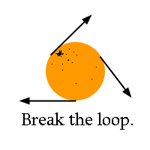

 | Tangentium |
March '04: Menu
All material on this site remains © the original authors: please see our submission guidelines for more information. If no author is shown material is © Drew Whitworth. For any reproduction beyond fair dealing, permission must be sought: e-mail drew@comp.leeds.ac.uk. ISSN number: 1746-4757 |
March 2004: Cyberspace and the Noösphere - Links and offline resources(Remember that all external links in this site open in the second browser window.) The biosphere and noösphereWe must begin this month's list of links with an admission that good online sources here are hard to find. Googling on "Biosphere" reveals commercial products or projects (such as the Biosphere 2 project in Arizona) or the "Ecosphere: a world of your own in an enclosed sphere for just $80"). Or it highlights links which introduce the concept in general terms, but in no more, and usually much less, detail than we have already attempted in our supplementary essay. Or, it is used as a synonym for "environment". When "noösphere" is added to the search, things become even more obscure: a great deal of the online writing here is of dubious value to say the least. While we are not opposed to spiritualism as a motivation for developing understanding and even action, it is difficult to draw productive conclusions from many of its online manifestations. While we welcome alternative opinions here, it does seem as if the best sources are all printed. The best place, online or off, to start is with the reissue of Vladimir Vernadsky's classic text, called simply The Biosphere (1999, New York, Copernicus). It is an accessible and relatively short book, and the reissue has a fine introduction and annotations. It does not develop the idea of the noösphere, but as the work that essentially defined the idea of the biosphere it is important reading. Vernadsky did begin to relate biosphere and noösphere in his 1945 essay (the obvious title of which has been borrowed by this month's supplementary essay), "The biosphere and the noösphere" in American Scientist 33/1, pp. 1-12. But the term "noösphere" is more commonly associated with its populariser, Pierre Teilhard de Chardin and his book, The phenomenon of man (1959, London, Collins). An exception to the general dearth of online sources here comes with Jennifer Cobb Kreisberg's Wired article on Teilhard. Rather than describe in detail the various ways in which these themes have developed, readers are directed to an excellent collection which has already done that work: Paul Samson and David Pitt's collection, The Biosphere and Noösphere Reader: Global environment, society and change (1999, London, Routledge). In this area one should also note the important contributions of Theodosius Dobzhansky. His work Human Culture: A Moment in Evolution (with E. Boesiger - 1983, New York, Columbia University Press) is an accessible introduction to his general ideas. M. B. Adams' collection, The Evolution of Theodosius Dobzhansky: Essays on his Life and Thought in Russia and America (1994, Princeton, Princeton University Press) is a good secondary text. The nature of cyberspace"Virtual geography" is a term that is becoming loosely applied to the questions of how (and whether) we can treat cyberspace as we treat real space: whether we can map it, identify separate sub-territories within it, and so on. The web site from Martin Dodge's course at UCL is a fairly comprehensive source of readings and ideas here. Dodge and Rob Kitchin have also published a book, The Atlas of Cyberspace. PostmodernismThis is the philosophical field most relevant to this month's Tangentium, although as we have tried to suggest, not all the applications of postmodernism are productive. Those seeking a readable, non-patronising introduction could try -- as is often the case -- the "Introducing.." series published by Icon Books, Cambridge. The two relevant works here are Introducing Postmodernism by Richard Appignanesi and Chris Garratt (1995), and Introducing Semiotics by Paul Cobley and Litza Jansz (1999). For more detailed and academic review, try Steven Best and Douglas Kellner's Postmodern Theory: Critical Interrogations (1991, Basingstoke, Macmillan). As for online links, there is again little point in repeating work that has already been done: so see Martin Ryder's bibliography of postmodern theory. | |